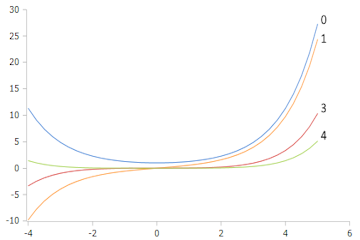Exponentially Scaled Bessel-Ie Function for Complex Numbers
Calculation of the exponentially scaled modified Bessel function \(I_e(z) = e^{-|z|} I_\nu(z)\) of the first kind
Bessel-Ie Function Calculator
Exponentially Scaled Bessel Function \(I_e(z)\)
The exponentially scaled Bessel function \(I_e(z) = e^{-|z|} I_\nu(z)\) prevents numerical overflows for large arguments and is especially useful for numerical calculations with large values.
Bessel-Ie Properties
Scaling
Exponential
Factor: \(e^{-|z|}\)
Prevents overflowBase
Bessel-I
Type: \(I_\nu(z)\)
Modified functionOrder
ν ∈ ℝ
Any real number
Integer or rationalArgument
z ∈ ℂ
Complex: a+bi
Real and imaginary partImportant Properties
- Numerically stable calculation for large |z|
- Prevents exponential overflow
- Defined as: \(I_e(z) = e^{-|z|} I_\nu(z)\)
- Asymptotically: \(I_e(z) \sim \frac{1}{\sqrt{2\pi|z|}}\) for |z| → ∞

Plot of the Bessel-I function (before exponential scaling)
|
|
Definition of the Exponentially Scaled Bessel Function
The exponentially scaled modified Bessel function \(I_e(z)\) is defined as:
Scaled Definition
Exponentially scaled version to avoid numerical overflows
Numerical Stability
Bounded for large |z|, prevents overflow
Relationship to Bessel-I
Back-transformation to the original function
Important Properties of the Scaled Bessel Function
Asymptotic Behavior
Constant asymptotic behavior without exponential growth
Numerical Advantages
Bounded values prevent overflow problems
Scaling Factor
Exponential damping factor based on the modulus of z
Recurrence Relations
Scaled recurrence relations apply analogously
Applications of the Scaled Bessel Function
Numerical Analysis
Scientific Computing
Statistical simulations
Random processes
Option pricing
Risk modeling
Signal Processing
Filter design
Spectral analysis
Beamforming
Physical Models
Diffusion equations
Heat conduction models
Quantum field theory
Scattering theory
Exponentially Scaled Bessel Functions - Detailed Description
Numerical Stability
The exponentially scaled Bessel function \(I_e(z)\) was specifically developed to solve the numerical problems of the ordinary modified Bessel function \(I_\nu(z)\) for large arguments.
• \(I_\nu(z)\) grows exponentially for large |z|
• Numerical overflows for |z| > 700
• Loss of precision in calculations
• Unstable algorithms
Solution Approach
By the definition \(I_e(z) = e^{-|z|} I_\nu(z)\), the exponentially growing part is "divided out", so that the resulting function remains numerically stable.
Advantages of Scaling
Without scaling: \(I_\nu(100)\) ≈ 10⁴³ (overflow)
With scaling: \(I_{e,\nu}(100)\) ≈ 0.056 (stable)
Mathematical Properties
The scaled function retains all important mathematical properties of the original Bessel function, but is numerically much more stable.
• Recurrence relations remain valid
• Differential equations analogous
• Symmetry relations persist
• Integral representations possible
Implementation
In numerical practice, the scaled version is used and the result is back-transformed if needed:
Back-transformation only when explicitly needed
Computer Implementation
Modern libraries use the scaled version automatically and handle the scaling transparently for the user.
Comparison: Scaled vs. Unscaled
Unscaled Bessel-I Function
Behavior: Exponential growth
Problems: Overflow for large |z|
Limit: |z| ≲ 700 (double precision)
Scaled Bessel-Ie Function
Behavior: Asymptotically constant
Advantages: No overflow
Range: All |z| (practically unlimited)
Practical Application Guidelines
- Small |z| ≤ 10: Both versions usable
- Medium |z| ≤ 100: Scaled version recommended
- Large |z| > 100: Only use scaled version
- Iterative algorithms: Always scaled version
- Scientific libraries: Automatic choice
- Special functions: Transparent scaling
Bessel Functions - Complete Definitions and Scaling
Modified Bessel Functions
The modified Bessel function of the first kind of order n is defined as:
The exponentially scaled version is:
The modified Bessel function of the second kind is:
Ordinary Bessel Functions
The Bessel function of the first kind of order n is defined as:
The Bessel function of the second kind of order n is:
Application Areas
The exponentially scaled Bessel function is particularly important in numerical mathematics, signal processing, quantum physics, and all areas where large argument values can occur. It enables stable calculations even in extreme parameter ranges.
|
|
|
|
More complex functions
Absolute value (abs) • Angle • Conjugate • Division • Exponent • Logarithm to base 10 • Multiplication • Natural logarithm • Polarform • Power • Root • Reciprocal • Square root •Cosh • Sinh • Tanh •
Acos • Asin • Atan • Cos • Sin • Tan •
Airy function • Derivative Airy function •
Bessel-I • Bessel-Ie • Bessel-J • Bessel-Je • Bessel-K • Bessel-Ke • Bessel-Y • Bessel-Ye •